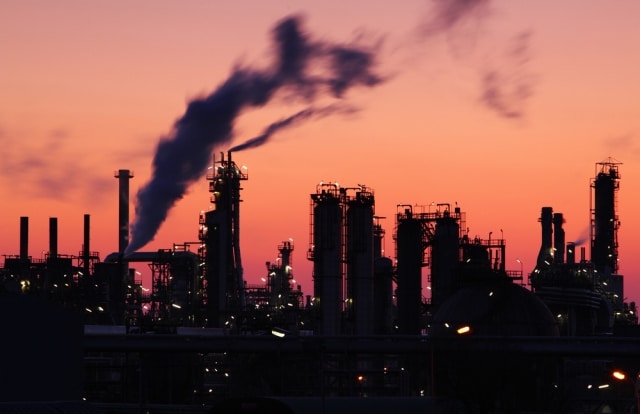This is a guest post by Caroline Selle
Much of the debate around the Keystone XL pipeline has focused on the dangers of extracting and transporting the tar sands. Left out, however, are those in the United States who are guaranteed to feel the impacts of increased tar sands usage. Spill or no spill, anyone living near a tar sands refinery will bear the burden of the refining process.
Tar sands oil is produced from a mixture of sand, clay, water, and the sticky, peanut-butter like form of petroleum known as bitumen. Unlike conventional crude, it’s essentially solid at room temperature, has a higher heavy metal content, and has to be diluted for transport. The diluents are trade secrets, and the content mixture – which often contains benzene, a human carcinogen – isn’t something companies are required to report.
DeSmogBlog has covered the impacts of tar sands extraction on indigenous communities, and the dangers of moving tar sands through a network of pipelines is aptly covered here. And while major nonprofits have completed studies on the dangers of transporting tar sands, there is significantly less information available on how refining tar sands differs from processing conventional crude.
Additional heavy metals and benzene might sound like a recipe for disaster anywhere, but the location of several major tar sands refineries is already overburdened with pollutants. In Harris County, Texas – home to the city of Houston – people are already surrounded by refineries and factories spewing toxic pollution into the air. And as the southern leg of the Keystone XL project slowly fills in its missing pieces, the spectre of toxic bitumen looms.
Harris County, Texas, is home to the Lyondell Houston Refinery. The Lyondell facility is expanding its ability to refine tar sands bitumen, attempting to more than double its capacity to process Canadian crude. Never mind that the refinery already has numerous Clean Air and Clean Water Act violations. If the facility expands as planned, its capacity will increase from 60,000 to 175,000 barrels a day.
The air quality in Harris County is already dangerous without the added burden of tar sands pollution. Although levels of many chemicals have decreased in recent years, residents are reaping the rewards of living so close to massive amounts of cancer-causing pollution. A 2006 study by the Texas government found increased rates of certain cancers in the Harris County population.
Children living in the areas with the highest level of 1,3 butadiene had a 153% higher chance of developing acute myeloid leukemia than those living in areas with the lowest concentrations of the same chemical. A 2003 study found a positive correlation between ozone density and asthma in Harris County residents, and the cancer risk of Houston residents living in the most contaminated areas is increased by a factor of 1000.
Though the Lyondell website advertises winning “13 national safety awards in the past five years,” the Lyondell Chemical Co. has the second highest rate of disposing of toxics of any industrial facility in Harris County. The more you learn, the worse it gets. In 2011, Harris County accounts for 14.74 percent of total Toxic Release Inventory (TRI) measured chemical releases and transfers in Texas. Texas already ranks 3rd highest (worst) in terms of pounds of toxics released and or transferred – out of 56 states and territories.
Lyondell Chemical Co. owns Houston Refining, a facility in Manchester, Texas which has been the subject of four formal EPA enforcement acts in the last five years. The company was fined $549,055 for violating the Clean Air Act, and yet, as of April, 2013, the facility has had 12 consecutive quarters of non-compliance. The area around Houston refining is 80% minority, with about one out of every four people below the federal poverty line.
Despite these grim statistics, the refinery was granted a pollution permit from the Texas Council on Environmental Quality without the requested public hearing in 2010. Residents were concerned about benzene exposure, which is likely to increase with greater refining of the tar sands. Already, the neighborhood has seen struggles over controlling the amount of benzene in the air.
A 2011 report by the Texas Center for Environmental Quality revealed decreasing levels of toxics in the air, but some residents claim that the data is based off of faulty and broken air quality monitors. Still, the decreasing levels are likely unsafe: Texas has some of the highest ‘safe’ benchmarks for carcinogens in the country. Additionally, the cumulative effect of lifetime exposure to a “toxic soup” of “safe” levels of chemicals is unknown.
With toxic chemical exposure nearly certain, it is unclear what the next step will be for residents of Harris County. It’s clear the area isn’t facing the impacts of the Keystone XL on the same timeline as the rest of the nation. President Obama already approved the lower leg of the pipeline, and the connection from Cushing, OK to Port Arthur, TX is almost complete.
Once built, the Cushing hub will connect to other pipelines and transportation systems moving tar sands from Alberta. For many residents of Harris County, this is a life or death struggle more immediate than the “what-if” of a pipeline spill. And it’s not a “what-if.” For Harris County, the fight is “right now.”
Image credit: Oil Refinery on Shutterstock
Subscribe to our newsletter
Stay up to date with DeSmog news and alerts






